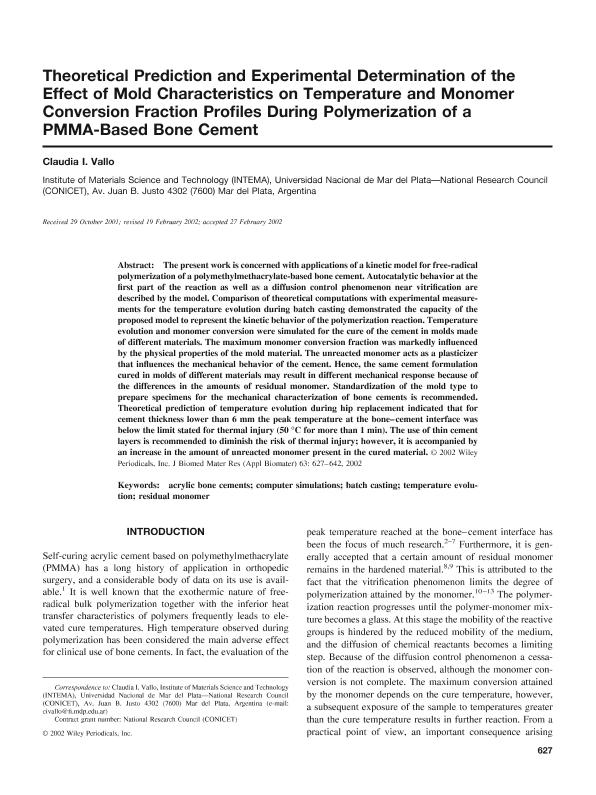Mostrar el registro sencillo del ítem
dc.contributor.author
Vallo, Claudia Ines

dc.date.available
2018-08-16T14:50:16Z
dc.date.issued
2002-12
dc.identifier.citation
Vallo, Claudia Ines; Theoretical prediction and experimental determination of the effect of mold characteristics on temperature and monomer conversion fraction profiles during polymerization of a PMMA-based bone cement; Wiley; Journal Of Biomedical Materials Research; 63; 5; 12-2002; 627-642
dc.identifier.issn
0021-9304
dc.identifier.uri
http://hdl.handle.net/11336/55872
dc.description.abstract
The present work is concerned with applications of a kinetic model for free-radical polymerization of a polymethylmethacrylate-based bone cement. Autocatalytic behavior at the first part of the reaction as well as a diffusion control phenomenon near vitrification are described by the model. Comparison of theoretical computations with experimental measurements for the temperature evolution during batch casting demonstrated the capacity of the proposed model to represent the kinetic behavior of the polymerization reaction. Temperature evolution and monomer conversion were simulated for the cure of the cement in molds made of different materials. The maximum monomer conversion fraction was markedly influenced by the physical properties of the mold material. The unreacted monomer acts as a plasticizer that influences the mechanical behavior of the cement. Hence, the same cement formulation cured in molds of different materials may result in different mechanical response because of the differences in the amounts of residual monomer. Standardization of the mold type to prepare specimens for the mechanical characterization of bone cements is recommended. Theoretical prediction of temperature evolution during hip replacement indicated that for cement thickness lower than 6 mm the peak temperature at the bone-cement interface was below the limit stated for thermal injury (50 °C for more than 1 min). The use of thin cement layers is recommended to diminish the risk of thermal injury; however, it is accompanied by an increase in the amount of unreacted monomer present in the cured material. © 2002 Wiley Periodicals, Inc.
dc.format
application/pdf
dc.language.iso
eng
dc.publisher
Wiley

dc.rights
info:eu-repo/semantics/openAccess
dc.rights.uri
https://creativecommons.org/licenses/by-nc-sa/2.5/ar/
dc.subject
Acrylic Bone Cements
dc.subject
Batch Casting
dc.subject
Computer Simulations
dc.subject
Residual Monomer
dc.subject
Temperature Evolution
dc.subject.classification
Recubrimientos y Películas

dc.subject.classification
Ingeniería de los Materiales

dc.subject.classification
INGENIERÍAS Y TECNOLOGÍAS

dc.title
Theoretical prediction and experimental determination of the effect of mold characteristics on temperature and monomer conversion fraction profiles during polymerization of a PMMA-based bone cement
dc.type
info:eu-repo/semantics/article
dc.type
info:ar-repo/semantics/artículo
dc.type
info:eu-repo/semantics/publishedVersion
dc.date.updated
2018-07-11T17:26:45Z
dc.journal.volume
63
dc.journal.number
5
dc.journal.pagination
627-642
dc.journal.pais
Estados Unidos

dc.journal.ciudad
Hoboken
dc.description.fil
Fil: Vallo, Claudia Ines. Consejo Nacional de Investigaciones Científicas y Técnicas. Centro Científico Tecnológico Conicet - Mar del Plata. Instituto de Investigaciones en Ciencia y Tecnología de Materiales. Universidad Nacional de Mar del Plata. Facultad de Ingeniería. Instituto de Investigaciones en Ciencia y Tecnología de Materiales; Argentina
dc.journal.title
Journal Of Biomedical Materials Research

dc.relation.alternativeid
info:eu-repo/semantics/altIdentifier/doi/https://dx.doi.org/10.1002/jbm.10334
dc.relation.alternativeid
info:eu-repo/semantics/altIdentifier/url/https://onlinelibrary.wiley.com/doi/abs/10.1002/jbm.10334
Archivos asociados
